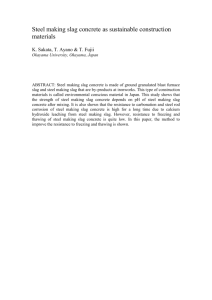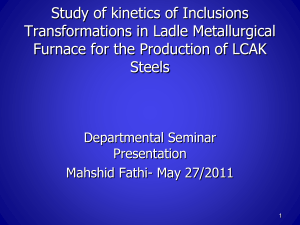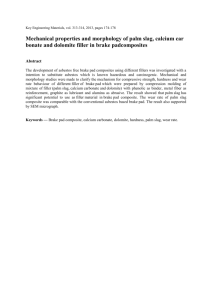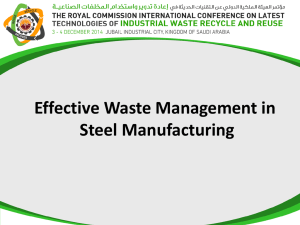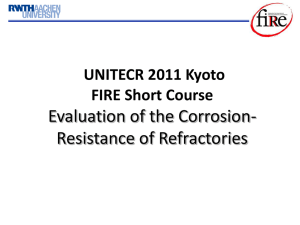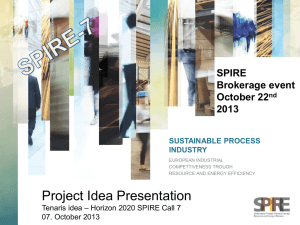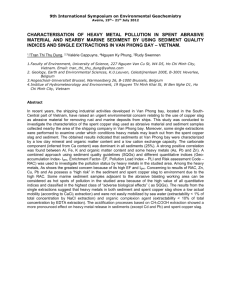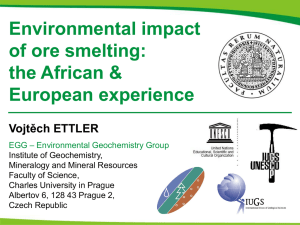Slag is a waste product from the pyrometallurgical processing of
advertisement
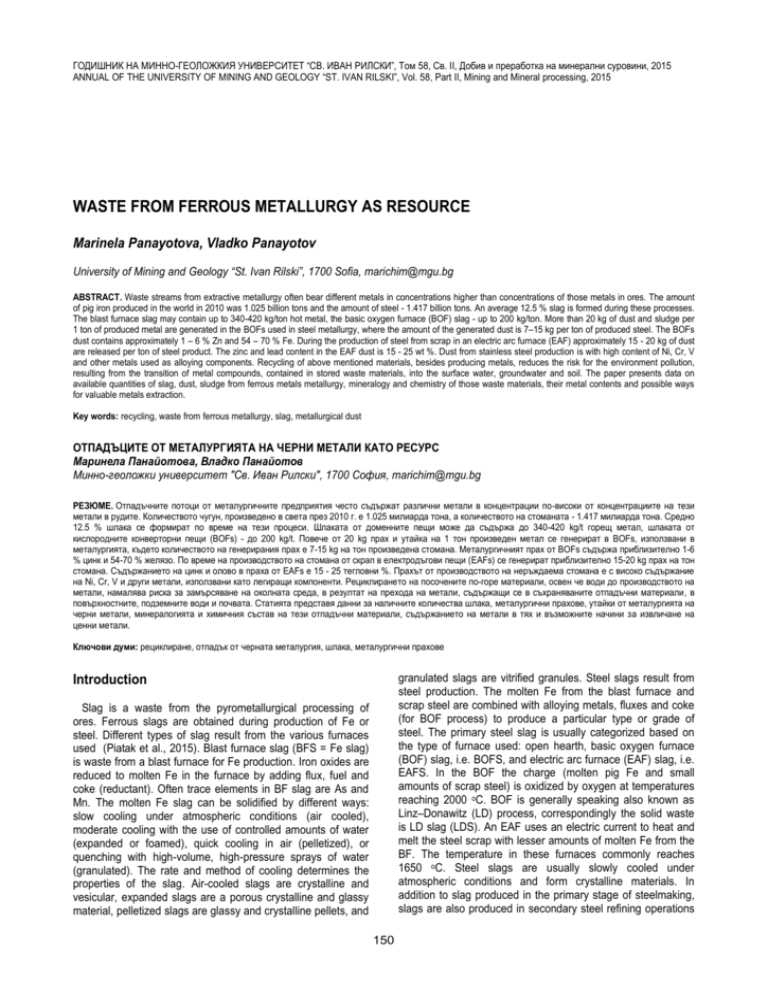
ГОДИШНИК НА МИННО-ГЕОЛОЖКИЯ УНИВЕРСИТЕТ “СВ. ИВАН РИЛСКИ”, Том 58, Св. II, Добив и преработка на минерални суровини, 2015 ANNUAL OF THE UNIVERSITY OF MINING AND GEOLOGY “ST. IVAN RILSKI”, Vol. 58, Part ІI, Mining and Mineral processing, 2015 WASTE FROM FERROUS METALLURGY AS RESOURCE Marinela Panayotova, Vladko Panayotov University of Mining and Geology “St. Ivan Rilski”, 1700 Sofia, marichim@mgu.bg ABSTRACT. Waste streams from extractive metallurgy often bear different metals in concentrations higher than concentrations of those metals in ores. The amount of pig iron produced in the world in 2010 was 1.025 billion tons and the amount of steel - 1.417 billion tons. An average 12.5 % slag is formed during these processes. The blast furnace slag may contain up to 340-420 kg/ton hot metal, the basic oxygen furnace (BOF) slag - up to 200 kg/ton. More than 20 kg of dust and sludge per 1 ton of produced metal are generated in the BOFs used in steel metallurgy, where the amount of the generated dust is 7–15 kg per ton of produced steel. The BOFs dust contains approximately 1 – 6 % Zn and 54 – 70 % Fe. During the production of steel from scrap in an electric arc furnace (EAF) approximately 15 - 20 kg of dust are released per ton of steel product. The zinc and lead content in the EAF dust is 15 - 25 wt %. Dust from stainless steel production is with high content of Ni, Cr, V and other metals used as alloying components. Recycling of above mentioned materials, besides producing metals, reduces the risk for the environment pollution, resulting from the transition of metal compounds, contained in stored waste materials, into the surface water, groundwater and soil. The paper presents data on available quantities of slag, dust, sludge from ferrous metals metallurgy, mineralogy and chemistry of those waste materials, their metal contents and possible ways for valuable metals extraction. Key words: recycling, waste from ferrous metallurgy, slag, metallurgical dust ОТПАДЪЦИТЕ ОТ МЕТАЛУРГИЯТА НА ЧЕРНИ МЕТАЛИ КАТО РЕСУРС Маринела Панайотова, Владко Панайотов Минно-геоложки университет "Св. Иван Рилски", 1700 София, marichim@mgu.bg РЕЗЮМЕ. Отпадъчните потоци от металургичните предприятия често съдържат различни метали в концентрации по-високи от концентрациите на тези метали в рудите. Количеството чугун, произведено в света през 2010 г. е 1.025 милиарда тона, а количеството на стоманата - 1.417 милиарда тона. Средно 12.5 % шлака се формират по време на тези процеси. Шлаката от доменните пещи може да съдържа до 340-420 kg/t горещ метал, шлаката от кислородните конверторни пещи (BOFs) - до 200 kg/t. Повече от 20 kg прах и утайка на 1 тон произведен метал се генерират в BOFs, използвани в металургията, където количеството на генерирания прах е 7-15 kg на тон произведена стомана. Металургичният прах от BOFs съдържа приблизително 1-6 % цинк и 54-70 % желязо. По време на производството на стомана от скрап в електродъгови пещи (EAFs) се генерират приблизително 15-20 kg прах на тон стомана. Съдържанието на цинк и олово в праха от EAFs е 15 - 25 тегловни %. Прахът от производството на неръждаема стомана е с високо съдържание на Ni, Cr, V и други метали, използвани като легиращи компоненти. Рециклирането на посочените по-горе материали, освен че води до производството на метали, намалява риска за замърсяване на околната среда, в резултат на прехода на метали, съдържащи се в съхраняваните отпадъчни материали, в повърхностните, подземните води и почвата. Статията представя данни за наличните количества шлака, металургични прахове, утайки от металургията на черни метали, минералогията и химичния състав на тези отпадъчни материали, съдържанието на метали в тях и възможните начини за извличане на ценни метали. Ключови думи: рециклиране, отпадък от черната металургия, шлака, металургични прахове Introduction granulated slags are vitrified granules. Steel slags result from steel production. The molten Fe from the blast furnace and scrap steel are combined with alloying metals, fluxes and coke (for BOF process) to produce a particular type or grade of steel. The primary steel slag is usually categorized based on the type of furnace used: open hearth, basic oxygen furnace (BOF) slag, i.e. BOFS, and electric arc furnace (EAF) slag, i.e. EAFS. In the BOF the charge (molten pig Fe and small amounts of scrap steel) is oxidized by oxygen at temperatures reaching 2000 oC. BOF is generally speaking also known as Linz–Donawitz (LD) process, correspondingly the solid waste is LD slag (LDS). An EAF uses an electric current to heat and melt the steel scrap with lesser amounts of molten Fe from the BF. The temperature in these furnaces commonly reaches 1650 oC. Steel slags are usually slowly cooled under atmospheric conditions and form crystalline materials. In addition to slag produced in the primary stage of steelmaking, slags are also produced in secondary steel refining operations Slag is a waste from the pyrometallurgical processing of ores. Ferrous slags are obtained during production of Fe or steel. Different types of slag result from the various furnaces used (Piatak et al., 2015). Blast furnace slag (BFS = Fe slag) is waste from a blast furnace for Fe production. Iron oxides are reduced to molten Fe in the furnace by adding flux, fuel and coke (reductant). Often trace elements in BF slag are As and Mn. The molten Fe slag can be solidified by different ways: slow cooling under atmospheric conditions (air cooled), moderate cooling with the use of controlled amounts of water (expanded or foamed), quick cooling in air (pelletized), or quenching with high-volume, high-pressure sprays of water (granulated). The rate and method of cooling determines the properties of the slag. Air-cooled slags are crystalline and vesicular, expanded slags are a porous crystalline and glassy material, pelletized slags are glassy and crystalline pellets, and 150 Available quantities, chemistry and mineralogy that adjust C content and remove remaining S, gases or impurities. Molten BOF and EAF steel may be refined in a ladle metallurgical furnace (LMF) with the possible addition of alloying metals and fluxes to produce different grades of steel. Thus, ladle slag (LMFS) is produced. Often trace elements in steel slag are As, Cr and Mn. Based on data published by World Steel Association (WSA, 2011) 1.417 billion tons of steel was produced in the world in 2010. The amount of hot metal (pig iron) is 1.025 billion tons. WSA estimates that an average 12.5% slag is formed during steelmaking. According to Genet (2000) slag production from blast furnace reaches a plateau around 260-270 kg/t of pig iron. The calculated amount of ironmaking slag which was produced in 2010 is around 271.63 million tons. The estimation of total iron and steelmaking slags in 2010 is 446 million tons. The amount of slag production will increase continuously in line with the increasing of steel production in the world. Van Oss (2013) estimated that 0.25–0.30 t of slag are generated per ton of pig iron in modern blast furnaces for typical Fe ore grades (60–66% Fe), while steel production furnaces typically generate 0.2 tonnes of slag per ton of crude iron. This slag, up to half of which is metal, is returned to the furnace (where advanced technologies are applied) for further metal recovery. After final processing, the steel slag generated is approximately 10–15% of crude steel output. Based on Fe and steel production data, approximately 260–330 Mt of BF Fe slag and approximately 150–220 Mt of steel slag were produced world-wide in 2011 (Van Oss, 2013). In 2000, 25.6 million tons of BFS was produced in Europe (Motz, 2002). It was estimated that 12 millions tons (Mt) and 8 Mt of BOF slag were generated annually in Europe and United States, respectively (Proctor et al., 2000; Motz, 2002). In Europe the total amount of steel slag generated in 2004 was about 15 million tons (Hiltunen and Hiltunen, 2004). Steel and steel slag annual output in 2010 in China reached to 626.7 million tons and 90 million tons respectively (Ren et al., 2012). The amount of deposited steel slag (mainly BOFS) in China has been estimated to more than 300 million tons, which leads to the occupation of farm land and pollution of groundwater and soil (Yi et al., 2012). Except of slag, the other solid waste types are dust / sludge from the control of air pollution in blast furnaces, dust / sludge from the control of air pollution in furnaces for steel production and refining. Studies of slag use are in three main directions: utilization as a construction material, environmental remediation applications and metals’ recovery. The hard and dense air-cooled BFS is suitable as a construction aggregate (Piatak et al., 2015). The cementitious properties of granulated slag are the basis for use in concrete for strength increasing. For example, of the 25.6 million tonnes of BFS produced in Europe in 2000, 66% was used for cement production and 23% - as aggregates for road construction (Motz, 2002). Pelletized and expanded slag (with low density) is used as a lightweight aggregate (Van Oss, 2013). The significant acid-neutralizing capacity, possessed by ferrous slag, due to the presence of Ca silicates, carbonates, and oxides, is used, for example to neutralize acid rock water. The BFS can be used also in the preparation of materials such as ceramic glass, silica gel, ceramic tiles, bricks, etc. (Das et al., 2007). In 2013, the Europe steel industry slag is used for road construction (45%), interim storage (17%), internal recycling (14%), fertilizer (3%), hydraulic engineering (3%), and for cement production (3%). However, the left amount was dumped into landfills or stockpiled for long periods at steel plants (Hocheng et al., 2014). Because of the presence of heavy metals, the steel industry slag is considered as hazardous waste (Langova and Matysek, 2010). Data from tests made by the Environmental Protection Agency (EPA,1990) of the United States show: a) The main contaminants that can leach from the slag from blast furnaces are Mn, Fe, Pb, As, Al, Ag, Hg, Sb; b) The main contaminants which can leach from the slag from the furnace for steel production (especially where older technology was applied or in historic piles of slag) are Mn, F, As, Pb, Ag, Fe, Mo, Ba. Taking into account only those elements that are relatively mobile in groundwater (given the existing slag management methods and expected pH levels of leachate), As and Hg can be referred to as contaminants which are the main potential threat at leaching of blast furnace slag. EPA analyzes show that: a) The main contaminants that can leach from the dust / sludge from the control of air pollution in blast furnaces are Mn, Pb, As, Al, Fе, Zn, F, Se, Tl, Ag, Hg, Cu, Sb, Cd, Cr, Ba, Ni; b) The main contaminants that can leach from the dust / sludge from the control of air pollution in furnaces for steel production are Zn, Mn, Cd, Fe, Mo, Pb, Se, Hg. Test data show that As, F, Se, Hg, Cd and Cr can be referred to as contaminants which are the main potential threat at leaching of dust / sludge from the control of air pollution in BF. Cadmium, Mo, Se and Hg are the greatest potential threat at leaching the dust / sludge from the control of air pollution in furnaces for steel production. For that reason questions are being raised on landfilling of steel industry slag, on its treatment in order to reduce its metal content, as well as on its recycling to extract valuable metals. More than 20 kg of dust and sludge per 1 ton of produced metal are generated in the BOFs used in steel metallurgy (Gargul, 2015), where the amount of the generated dust is 7– 15 kg per ton of produced steel (Trung et al., 2011). This waste contains many non-ferrous metals, such as zinc. The content of this metal in dusts ranges from 1 to 6% (Gargul, 2015). Slag, dust / sludge from iron and steel production should be properly stabilized / treated in order to protect the environment and even more - they can be beneficiated as resources. For example, the EAF dust is rich in Zn / Pb. It is estimated that the world-wide annual production of EAF dust is as high as 5 million tons, all of which must be treated / recycled or land filled (Hughes et al., 2007). According to Das et al. (2007) the slag / sludge from an average plant in India contain hot metal, in kg/ton: 340-421 - in BFS, 28 - in BF dust / sludge, 200 - in LDS, 15-15 - in LD sludge, 22 - in mill scale, and 12 - in mill sludge. The chemistry and mineralogy of slag / dust depend on the metallurgical processes that create the material. Table 1 summarizes the major, minor, and trace element chemistry of different slag types from over 100 samples from over 40 studies (Miklos, 2000; Windt et al., 2011; Yi et al. 2012; Zultan, 2013; Chiang et al., 2014; Das et al., 2014, Piatak et al., 2015) - some of them, summarized by Piatak and co- 151 authors (2015). When the average (av.) is given, this is the average value, appearing in the work of Piatak and co-authors. 2013). Dust coming from carbon steel production is with high content of zinc (up to 40 %), mainly due to processing of galvanized steel scrap (Kukurugya, 2013). Dust from stainless steel production is with high content of Ni, Cr, V and other metals used as alloying components. Dusts can be used to recover metals (Zn, Cr and Ni), because of the: decreasing supply of primary raw materials, increasing price of chromium, nickel and zinc, and higher content of metals compared to primary raw materials. The chemical composition of BFS is not much different between different blast furnaces because most BFs operate within the same chemical constraints. The content of NiO, Cr2O3 and CuO in blast furnace slag can be ignored because the presence of these components in the blast furnace charging material is strictly prohibited and well controlled (Zulhan, 2013). In addition of components, presented in Table 1, the convertor slag may contain other metals, such as Ni (1%), Cu (0.7 %), Co (0.65 %), Zn (0.15 %), Pb (0.05 %) (Perederiya et al., 2011). The chemical composition of BF flue dust from India plants is presented in Table 2 (Das et al., 2007). The chemical composition of steel-making plants flue dust from different producers is presented in Table 3 (Hughes et al., 2008; Trung et al., 2011, Zhang, 2012; Kukurugya, Table 1. Major, minor, and trace elements in different slag types Component, % BFS BFS pre-1990 (av.) CaO 39-42 15.2 SiO2 33-39 45.2 Al2O3 9-14.3 10.6 Fe2O3 FeO 1.6 = Fetot av. 16.1= Fetot av. MgO 6-9 8.87 MnO 0.1-1.9 0.95 TiO2 0.4-3.0 0.79 P2O5 P S 1.2-1.4 0.19 Cr2O3 C V K2O 0.99 (av.) 1.41 Na2O 0.49 (av.) 0.36 LOI 1.86 (av.) 0.65 1 The main phases identified in steelmaking dust from carbon steel production are: franklinite ZnFe2O4, magnetite Fe3O4, zincite ZnO, quartz SiO2. The most frequently occurring phases in dusts from stainless steel production are: chromite FeCr2O4, magnetite Fe3O4, calcite CaCO3 and calcium silicate CaSi2O4. BOFS EAFS BOFS sludge1 42-60 9-15 0.5-5 3-9 7-20 1-13 2-10 0.66 (av.) 1-4 30-50 10-20 10-18 5-6 8-22 8-13 5-10 0.66 (av.) 2-5 8.9-10.59 0.71-1.97 0.32-0.95 1.43-2.79 76.93-79.58 0.38 0.10-0.24 <0.30 <2 <0.25 <2 0.06 - 0.25 0.24 (av.) 0.16 (av.) 3.55 (av.) 0.24 (av.) 0.16 (av.) 3.55 (av.) 0.101-0.126 Slag fines (BOFS and EAFS)2 15.46-36.10 4.94-11.94 3.07-7.59 17.54-52.64= Fetot av. 1.39-13.63 0.99-5.31 0.06-0.33 0.01-1.25 0.06-1.69 0.14-2.53 Data from Das et. al. (2007) only; 2 Dry based, data from Ma and Houser (2014) Table 2. Chemical composition of BF flue dust from India plants Consti C Fe2O3 SiO2 Al2O3 CaO tuent % 29.9051.10 6.315.12- 4.9033.62 -49.50 8.30 2.54 1.96 MgO Pb Zn MnO K2O Na2O Fetot 0.881.33 0.0240.019 0.0420.028 0.580.02 1.220.154 0.470.07 35.734.62 The most frequently occurring phases in dusts from stainless steel production are: chromite FeCr2O4, magnetite Fe3O4, calcite CaCO3 and calcium silicate CaSi2O4. Zinc presents as ZnO and/or zinc ferrite ZnFe2O4 (Kukurugya, 2013). ZnO is very easily soluble even in low concentrated acidic or an alkaline solution, but zinc ferrite – ZnFe2O4 is a very stable phase which is soluble only in very strong acid solutions at high temperature. Chromite is very stable phase. Mixed metal oxides, such as Ni0.25Zn0.75Fe2O4 also can be found. ((Ca,Fe)2SiO4)-, melilite-, and pyroxene group phases, mullite (Al6Si2O13), garnet (X3Y2(SiO4)3), glass, and calcite (CaCO3) Fe and Ti oxides were also mentioned (Piatak et al., 2015). The mineralogy of modern Ca-rich steel-making Fe slag includes mostly pseudowollastonite and gehlenite (Ca2Al2SiO7). Melilites, in particular gehlenite, were the most often reported phase in Fe slag that was cooled slowly. Other most reported silicate phases are Ca and / or Mg silicates (olivine group, merwinite (Ca3Mg(SiO4)2), bredigite (Ca14Mg2(SiO4)8), wollastonite (CaSiO3) and glass. Calcium sulfide (oldhamite) and Fe metal were also identified in minor to trace amount. Steel slag is composed mostly of di-Ca silicate (Ca2SiO4, larnite), tri-Ca silicate (Ca3SiO5, rankinite), and Ca oxide (CaO, lime) if slags are cooled slowly and The primary mineralogy of the pre-1900 Fe slag include quartz, plagioclase ((Na,Ca)(Si,Al)4O8) and cristobalite. Other Ca-rich silicates and aluminosilicates identified were olivine 152 crystalline phases are formed; if the slag was quenched it represents mainly Ca silicate glass. Aluminum, Fe, and Mg are less abundant and are generally present in Ca silicates that can accommodate these elements, e.g., monticellite (CaMgSiO4), melilite, and merwinite. Al, Fe, and Mg oxide phases including spinels and SiO2 (quartz or cristobalite) are generally found in steel slags (Piatak et al., 2015). Looking at mineral chemistry, the most reported primary phases in ferrous slag are olivine-group phases with the general formula (Ca, Fe, Mg,Mn)2SiO4. Larnite is the most common, followed by monticellite; forsterite (Mg2SiO4), fayalite (Fe2SiO4), and kirschsteinite–glaucochroite (CaFeSiO4–CaMnSiO4) were also reported. The next reported phases in ferrous slags are oxides [(Ca, Fe, Mg, Mn)O] and melilites. Glass present in only trace amounts and it is usually dominated by the following major elements expressed as oxides: SiO2, CaO, Al2O3, and MgO (Piatak et al., 2015). available Zn. Zinc from Zn-bearing blast furnace wastes may be also separated by froth flotation and wet cyclone methods. Treated blast furnace dust, containing around 1% Zn, can be pelletized and sent to sinter plant. Waelz kiln (rotary kiln) can be used to reclaim Zn and Pb from BF sludge. The Institute of Gas Technology, USA has developed a fluidized-bed process for recovering directly reduced iron from BF flue dust. Up to 95% of the iron oxides contained in the waste stream could be reduced to elemental iron. Studies showed that it is possible to recover coke fines from BF flue dust with more than 80% carbon with 30% yield by column flotation techniques. The flotation tailings are rich in magnetite and can be recovered by low intensity magnetic separation technique giving a product with 62–65% Fe at a yield of 30% (Das et al., 2007). Three ways of BOFS recycling were considered (Chen et al., 2011): (1) Hot slag splashing technology, followed by slag crushing, and magnetic separation. Most of the recycled Fe returns to sintering process, some - to the BF smelting process, and little - to the BOF smelting process. The method is simple, requires low investment and is applicable in small and medium iron and steel enterprises. (2) Water quenching is used to treat the steel slag. Then the slag is crushed and magnetic separation process is adopted for recycling iron. The residue goes through a multiple crushing / magnetic process repeatedly, before being sent to the fine powder production workshop or sintering process as material. About 44% of the recycled iron returns to sintering process, and about 47% of that returns to the BF smelting process, while only about 7% returns to the BOF smelting process. Because this treatment is more complex and requires higher investment, it is suitable for large to medium iron and steel enterprises. (3) Both water quenching and wind quenching are used to treat the slags from different BOF smelting sections. Steel slag can be divided into five types, e. g. converter slag, desiliconization slag, desulfurization slag, dephosphorization slag, and refining slag. Water quenching technology is only suitable to treat desiliconization slag, while wind quenching is adopted to treat others. The slag from water quenching is dealt with processes introduced in (2). The iron in crushed slag from wind quenching is with fine particles. Most of the Fe recycled could be returned to the BOF smelting process directly. All of the residual sulfurization slag returns to sintering. All of the residual converter slag and refining slag returns to BOF or in BF. Some of the residual dephosphorization slag returns to sintering and the other as well as residual desiliconization slag are sent to the fine powder production workshop as material. Table 3. Chemical composition of steel-making plants flue dust Element EAF BOF EAF EAF Carbon Stainless Zn Fe Pb Cd As Sb Sn Cu Cr Ni Co S Ti 21.6-25.8 23.1429.5 1.3-3.45 0.58 0.12 0.01 0.23 0.1-0.2 2.74 47.7 17.05-33.0 24-45 0.18 0.2-4.05 0.9 0.96-8.1 19.3735.88 0.29-1.4 0.48 0-0.81 0-0.1 9.99-18.6 1.4-4.1 0.31 0.200 0.100 0.010 0.090 0.020 0.5 Si Mn 1.70 0.61 Mn 0.49 Mg 1.5-1.6 Mg 0.55 CaO 5.0-6.64 Ca 6.80 Al Si 0.37-0.53 1.87-2.62 0.34-1.12 Mn 1.034.11 Ca 0.9-4.42 Al 0.0480.096 1.7-2.69 Mn 1.674.55 Mg 2.193.28 Ca 4.7110.84 0.21-0.39 Studies on metals extraction Hydrometallurgical processing of BOF sludge in the H2SO4 solutions under atmospheric pressure and temperatures up to 100 °C, carried out at laboratory scale, at optimum conditions, resulted to 70% extraction of available zinc. Iron was removed from the solution by pH adjustment (Trung et al., 2011). BF flue dust usually bears some undesirable elements (Zn, Pb and alkali metals) that can cause operational difficulties at dust recycling in the furnace. Sometimes the dust contains toxic elements (Cd, Cr and As), which make it hazardous waste. A suitable beneficiation method has to be applied before dust recycling to the BF. Acid leaching, leaching with CaCl2, NH4Cl, etc. has been suggested for dealkalification of BF dust. BF flue dust and sludge is leached under both acid and oxidizing conditions for recovery of Zn and Pb. After separating the carbon and iron from the leaching solution, the latter can be passed through an anion exchanger to remove Zn and Pb and then recirculated to the reactor (Das et al., 2007). Selective leaching by low concentration H2SO4 at room temperature was reported to recover about 80% of initially The non-magnetic Fe2O3 part in the converter slag (steel slag) could be efficiently reduced to magnetic iron by pure H2, and CO at a temperature below 1000 oC. The slag after precise reduction had high degree of dispersion and did not get sintered. The reduced material was enriched by magnetic separation. By using magnetic sorting, precise reduction and magnetic separation 33 kg iron particles, 150 kg iron-rich material and 700 kg cement could be obtained from each ton slag (Gao et al., 2011). To recover Fe from a slag, rich in 153 fayalite, it was rapidly reduced (before fayalite melted) with carbon added pellets. Then Fe was recovered by nugget iron reduction process. Addition of CaO and Al2O3 spurred the reduction of fayalite. The metallization rate was 88. 43% under the optimized conditions (Cheng et al, 2013). sufficiently high iron contents and low levels of impurities, to be reused (Ma and Houser, 2014). Bioleaching of 76–78% Zn and Al from EAF sludge was demonstrated by Solisio et al. (2002) using At. ferrooxidans in presence of a sulfur containing substrate. Bioleaching was studied for recovering metals from EAF slag. Different cultures were tested. The slag pH was reduced initially from 11.2 to 8.3 by water-washing. At. thiooxidans culture supernatant containing 0.016 M H2SO4 was found most effective for bioleaching of metals. Repeated bioleaching cycles lead to metal recoveries of 75%, 60% and 27%, for Mg, Zn and Cu respectively (Hocheng et al. 2014). High pressure oxidative acid leaching (HPOXAL) was used to treat slow-cooled converter slags from Vale’s operations in Sudbury (Ontario, Canada). Extractions of Ni, Co and Cu exceeded 95–97% after 45 min at 250 ◦C, 70 g/L initial H2SO4 and 90 psi O2 overpressure (Perederiya et al., 2011). Coleaching of pyrrhotite tailings (with 0.6% Ni content) - as a source of sulphuric acid - with converter slags at the same temperature, oxygen partial pressure and equivalent stoichiometric H2SO4 amount had a similar kinetics to that of leaching with sulphuric acid. Fayalite and magnetite from the slag are dissolved by sulphuric acid, releasing ferrous and ferric iron into the solution. Ferrous iron is then oxidized and ferric iron is hydrolyzed, thus regenerating acid. The following reactions take place: Fe2SiO4 +4H+ = 2Fe2+ +H4SiO4(aq) (1) Fe3O4 +8H+ = Fe2+ +2Fe3+ +4H2O (2) Fe2+ +1/4O2 +H+ = Fe3+ +1/2H2O (3) 2Fe3+ +3H2O = Fe2O3 +6H+ (4) Most of dusts from steel making are recycled through sinter making in more advanced countries. There are two types of processing methods: pyrometallurgical and hydrometallurgical or their combination. One of the major problems related to steelmaking dust processing is its chemical and mineralogical heterogeneity. That's why it is difficult to design “versatile” technology for processing steelmaking dusts. The technology must be adjusted to chemical and mineralogical composition of concrete steelmaking dust. Pyrometallurgical processes generally are expensive and energy consuming, compared to hydrometallurgical ones. Problems related to hydrometallurgical processes are the necessity of eliminating Fe, Cd, Ni, Co etc. from the leachate and the large consumption of acid for iron oxides digestion. Compared to atmospheric leaching, HPOXAL requires significantly less H2SO4 due to acid regeneration. It was found that an acid addition of only 20 wt% of slag weight is needed, while a minimum of 175 wt% would be required stoichiomet rically according to reactions 1 and 2 at atmospheric leaching (without acid regeneration). In order to use BOF dusts as iron-bearing material in ferrous metallurgy, the Zn content has to be < 1%. Ammonia leaching (using NH4Cl, (NH4)2CO3 and NH4OH) was proposed to transfer Zn from BOF waste into the liquid phase with minimal loss of iron in this process (Gargul, 2015). An alkaline roasting – acid leaching was proposed for extracting vanadium from LD slag. The maximum V recovery of ca. 95% was achieved at 70 °C, S/L = 1/15, 3 M H2SO4 and leaching time of 150 min. It was found that the maximum extraction was achieved at the particle size < 0.850 mm (Aarabi-Karasgani et al., 2010). Valuable metals (V and Cr) can be recovered (at 98% metalization of slag) from LD slag by smelting reduction technique using a Tamman furnace. The slag can also be reduced in an electric furnace to separate the slag and metal (Das et al., 2007). A technology for recovering of Zn from EAF dust by leaching in NaOH solution with lead carbonate as additive and facilitated by mechanical activation was proposed. Around 45% Zn in EAF dusts can be extracted, compared to 25% Zn extracted by chemical leaching of non-activated samples (Zhanga et al., 2012). Direct smelting of EAF dust by applying Ausmelt Top Submerged Lancing Technology (TSLT) can be carried out by two process routes: (1) smelting and reduction in a two stage batch process producing ZnO fume and a discardable slag (with 1% Zn), and (2) continuous smelting by producing ZnO fume with periodic slag tapping producing a slag with 1% Zn. Zinc recoveries, are summarized in Table 4. The TSL technology at Korea Zinc treats EAF dust and produces benign slag for construction and (after alkali washing of the TSL reactor product) cake entering the Zn plant (Hughes et al., 2008). Magnetic portions of the steelmaking slags (BOFS, EAFS and LMFS) are often screened into three products: “A” scrap with particles above 75 (or 50) mm, “B” scrap - with particles between 75 (or 50) mm and 12.5 (or 9.5) mm and “C” scrap with particles below 12.5 (or 9.5) mm. “A” scrap is often recycled back into the steelmaking process. “B” scrap is usually recycled in the BF ironmaking process. Both “A” scrap and “B” scrap, in general, do not pose any problem in recycling. However, due to the low iron grades, high impurity concentrations, and small particle sizes, “C” slag fines cannot be economically or environmentally friendly recycled back into ironmaking and steelmaking processes in significant amounts without further treatment. A recycling technology of weak magnetic separation (below 1000 G, and especially between 200 and 800 G) coupled with selective particle size screening has been developed at Arcelor Mittal Global R&D - East Chicago Laboratories for recycling of steelmaking slag fines (“C” scrap). Clean iron-rich products are obtained, with Table 4. Results at applying TSLT direct smelting to EAF dust Stage Input Output Fume Slag 154 Zn 21.625.8 Pb 1.31.9 Fe 29.524.2 SiO2 45.6 CaO 79.3 56.759.7 0.10.7 5.35.9 0.050.1 0.31 1.52.4 0.1 Conclusions Langova, S., D. Matysek. Zinc recovery from steel-making wastes by acid pressure leaching and hematite precipitation. Hydrometallurgy, 101, 2010. -171–173. Ma, N., J. B. Houser. Recycling of steelmaking slag fines by weak magnetic separation coupled with selective particle size screening, J. of Cleaner Production, 82, 2014. -221231. Miklos, P. The Utilization of Electric Arc Furnace Slags in Denmark, Proceedings of 2nd European Slag Conference, Duesseldorf, 2013. -101-110. Motz, H.. Production and Use of Air-Cooled Blast Furnace and Steel Slags. Proceedings of 3th European Slag Conference, 2002.-7-20. Perederiya, I., V. G. Papangelakisa, M. Buarzaigab, I. Mihaylov, Co-treatment of converter slag and pyrrhotite tailings via high pressure oxidative leaching, J. Hazard. Mat., 194, 2011. -399–406. Piatak, N. M., M. B. Parsons, R. R. Seal II. Characteristics and environmental aspects of slag: A review. Applied Geochemistry, 57, 2015. - 236–266. Proctor, D.M., K.A. Fehling, E.C. Shay, J.L. Wittenborn, C. Avent, R.D. Bigham, M. Connolly, B. Lee, T.O. Shepker, M.A. Zak. Physical and chemicalcharacteristics of blast furnace, basic oxygen furnace, and electric arc furnace steel industry slags. Environ. Sci. Technol., 34, 2000. 1576–1582. Ren, Q, Y.J. Wang, S. Li. Technologies of steel slag and compre-hensive utilization of resouces. J. Iron Steel Res., 40. 2012.-54-57. Solisio, C., A. Lodi, F, Veglio, 2002. Bioleaching of zinc and aluminium from industrial waste sludges by means of Thiobacillus ferrooxidans. Waste Manage., 22, -667–675. Trung, Z.H., F. Kukurugya, Z. Takacova, D. Orac, M. Laubertova, D. Miskufova. Acidic leaching both of zinc and iron from basic oxygen furnace sludge. J. Hazard. Mat., 192, 2011.-1100–1107. Van Oss, H.G.. Slag, Iron and Steel: U.S. Geological Survey, 2011 Minerals Yearbook, 1, 2013. -69.1–69.9. Windt L.D., P. Chaurand, J. Rose. Kinetics of steel slag leaching: Batch tests and modeling. Waste Manage., 31, 2011.- 225–235. WSA. World Steel Association. Steel Statistical Yearbook, Worldsteel Committee on Economic Studies, Brussels, 2011. Yi, H., G. Xu, H. Cheng, J. Wang, Y. Wan, H. Chen. An overview of utilization of steel slag. Procedia Environmental Sciences, 16, 2012. - 791 – 801. Zhang C., J. Wang, J. Bai, Y. Zhao. Recovering of zinc from solid waste bearing sphalerite or zinc ferrite by mechanochemical extraction in alkaline solution, Procedia Environmental Sciences, 16, 2012.- 786 – 790. Zhanga, C., J. Wanga, J. Baia, Y. Zhaob. Recovering of zinc from solid waste bearing sphalerite or zinc ferrite by mechano-chemical extraction in alkaline solution. Procedia Environmental Sciences, 16, 2012. -786 – 790. Zulhan Z. Iron and Steelmaking Slags: Are They Hazardous Waste? ASEAN Iron and Steel Sustainability Forum, Nov., 2013. Slags, dusts and sludges from the control of air pollution resulting from iron and steel production have to be regarded as sources of iron and of non-ferrous metals. To extract valuable metals pyrometallurgical and hydrometallurgical technologies, facilitated by mineral beneficiation technologies (magnetic separation, flotation) can be applied, depending on the waste type, chemistry and mineralogy. References Aarabi-Karasgani, M., F. Rashchi, N. Mostoufi, E. Vahidi. Leaching of vanadium from LD converter slag using sulfuric acid. Hydrometallurgy, 102, 2010. -14–21. Chen, B., J. Yang, Z. Ouyang. Life Cycle Assessment of Internal Recycling Options of Steel Slag in Chinese Iron and Steel Industry. J. of Iron and Steel Int.., 18, 2011.- 3340. Cheng, X., K. Zhao, Y. Qi, X. Shi, C. Zhen. Direct Reduction Experiment on Iron-Bearing Waste Slag, J. Iron and Steel Int., 20, 2013. -24-29. Chiang, Y.W., R.M. Santos, J. Elsen, B. Meesschaert, J.A. Martens, T.V. Gerven. Towards zero-waste mineral carbon sequestration via two-way valorization of ironmaking slag. Chem. Eng. J., 249, 2014.- 260–269. Das, B., S. Prakash, P.S.R. Reddy, V.N. Misra. An overview of utilization of slag and sludge from steel industries. Resources, Conservation and Recycling, 50, 2007 40–57. EPA. Report to Congress on specials wastes from mineral process-sing, vol. II: Methods and Analyses, Office of Solid Waste, United States Environmental Protection Agency US EPA, 1990.-516 p. Gao, J., S. Li, Y. Zhang, Y. Zhang, P. Chen, P. Shen. Process of Re-Resourcing of Converter Slag. J. Iron Steel. Res, 18, 2011. -32-39. Gargul, K., B. Boryczko. Removal of zinc from dusts and sludges from basic oxygen furnaces in the process of ammoniacal leaching, Arch. Civil Mech Eng., 15, 2015. 179–187. Genet, M. Slag Usage Around the World – Opportunities and Challenges, Proc. 2nd European Slag Conference, 2000. 23-35. Hiltunen, R., A. Hiltunen. Environmental aspects of the utilization of steel industry slags. In: VII International Conference on Molten Slags, Fluxes and Salts. The South African Institute of Mining and Metallurgy, 2004. -357–362. Hocheng, H., C. Su, U. Jadhav. Technical Note, Bioleaching of metals from steel slag by Acidithiobacillus thiooxidans culture supernatant. Chemosphere 117, 2014. - 652–657. Hughes, S., M.A. Reuter, R. Baxter, A. Kaye. Ausmelt technology for lead and zinc processing. The Southern African Institute of Mining and Metallurgy Lead and Zinc 2008. -147-162. Hughes, S., R. Matusewicz, R. Reuter, D. Sherrington. Ausmelt – Extracting Value from EAF dust, Proceedings of EMC 2007, vol. III, Zinc and Lead.-1194-1208. Kukurugya, F., T. Havlik, L. Parilak. Characterization of finegrained wastes generated during carbon steel and stainless steel production XX Int. Student’s Day of Metallurgy Cracow, 2013. Acknowledgements. This work was supported by the project FK14/2015 at the University of Mining and Geology – Regulation No 9 for Scientific and Research Projects. The article has been reviewed by Assoc.prof. N. Mincheva and recommended for publication by department “Chemistry”. 155
